The Holy See and the U.N.
- GEORGE WEIGEL
This past November, in an interview with a leading Italian daily, Cardinal Angelo Sodano, the Vatican Secretary of State, said that he would not exclude the possibility of the Holy See becoming a full member of the United Nations, where it presently is a permanent observer.
 |
Cardinal
Angelo Sodano |
The cardinals suggestion may have come in response to a campaign orchestrated by the the anti-Catholic lobby, Catholics for a Free Choice, aimed at stripping the Holy See of its permanent observer status. The success of any such campaign seems very unlikely. But perhaps Vatican officials think that altering the Holy Sees form of participation at the U.N., from permanent observer to member, would torpedo this entire (blatantly bigoted) exercise.
It is important to
remember that the Holy See, not Vatican City State, exchanges diplomatic representation
with over 175 countries, holds permanent observer status at the U.N., and is represented
diplomatically at the European Union, the Organization for Security and Cooperation
in Europe, and the Organization of American States. What is the Holy See?
Here, some legal technicalities are unavoidable.
According to a
centuries-long development of understanding, recognized in international law and
diplomatic custom, the Holy See is the juridical embodiment of the worldwide
pastoral ministry of the Bishop of Rome as the head of the Catholic Church
itself a sovereign community, in the specific, technical sense that it has,
of itself, all the means necessary to achieve its (spiritual) ends. Because of
this, the Holy See has legal personality for purposes of international law and
diplomacy: it can send and accept diplomatic representatives; it can sign international
treaties; it can
The legal personality of the Holy See does not depend on
the fact that Vatican City is an independent state. Diplomats are normally said
to be accredited to the Vatican, but this is journalistic shorthand for the
Holy See, for its to the Holy See that diplomats are in fact accredited. Indeed,
in the years between 1870 (when the Pope became the prisoner of the Vatican)
and the Lateran Treaty of 1929 (which created an independent Vatican City State),
the Holy See continued to send out nuncios and receive ambassadors. During those
fifty-nine years, the Holy Sees legal personality wasnt changed by the fact
that the Pope no longer ruled a defined piece of territory; the Pope remained
the sovereign head of the Catholic Church, which is the essential element in the
equation.
This arrangement has many advantages. The fact that the
Holy See speaks in international organizations underscores the fact that the Churchs
presence is one of moral witness and service. The Holy See is not a state, and
the way it functions in international meetings, through permanent observer status,
helps underline that. In a word, the Holy See is a uniquely disinterested party
in international public life, speaking for the universal common good and not for
any particular national interest.
These may seem utterly arcane matters,
of interest only to international lawyers and diplomats. In fact, though, what
is at stake here is the Churchs public witness on the international plane. How
is that witness to be exercised in the world of international diplomacy, and in
a way that communicates the Churchs distinct mission? Would the Churchs moral
voice be muted or confused as another member of a club of states?
The Church has a right to a place at the table where the ought question of the human future are being debated. How it sits at that table will inevitably color what it says and how it is heard. Cardinal Sodano has raised some very large questions indeed.
![]()
 This is Meaghen Gonzalez, Editor of CERC. I hope you appreciated this piece. We curate these articles especially for believers like you.
This is Meaghen Gonzalez, Editor of CERC. I hope you appreciated this piece. We curate these articles especially for believers like you.
Please show your appreciation by making a $3 donation. CERC is entirely reader supported.

Acknowledgement
George Weigel "The Holy See and the U.N." The Catholic Difference. 2003
Reprinted with permission of George Weigel.
The Author

 George Weigel is a Distinguished Senior Fellow of the Ethics and Public Policy Center in Washington, D.C. He is author of The Fragility of Order: Catholic Reflections on Turbulent Times; Lessons in Hope: My Unexpected Life with St. John Paul II; Evangelical Catholicism: Deep Reform in the 21st-Century Catholic Church; Witness to Hope: The Biography of Pope John Paul II; Roman Pilgrimage: The Station Churches; Evangelical Catholicism; The End and the Beginning: John Paul II—The Victory of Freedom, the Last Years, the Legacy; God's Choice: Pope Benedict XVI and the Future of the Catholic Church; Letters to a Young Catholic: The Art of Mentoring; The Courage to Be Catholic: Crisis, Reform, and the Future of the Church; and The Truth of Catholicism: Ten Controversies Explored.
George Weigel is a Distinguished Senior Fellow of the Ethics and Public Policy Center in Washington, D.C. He is author of The Fragility of Order: Catholic Reflections on Turbulent Times; Lessons in Hope: My Unexpected Life with St. John Paul II; Evangelical Catholicism: Deep Reform in the 21st-Century Catholic Church; Witness to Hope: The Biography of Pope John Paul II; Roman Pilgrimage: The Station Churches; Evangelical Catholicism; The End and the Beginning: John Paul II—The Victory of Freedom, the Last Years, the Legacy; God's Choice: Pope Benedict XVI and the Future of the Catholic Church; Letters to a Young Catholic: The Art of Mentoring; The Courage to Be Catholic: Crisis, Reform, and the Future of the Church; and The Truth of Catholicism: Ten Controversies Explored.


